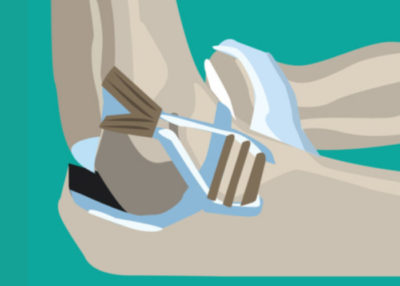Elbow UCL/MCL Surgeon

Are you an athlete who participates in repetitive overhead movements like tennis or pitching? If so, you are at an elevated risk of tearing the ulnar collateral ligament (UCL), also called the medial collateral ligament (MCL). If an elbow UCL tear is too severe for non-operative treatment, a special UCL repair procedure, called Tommy John surgery, is recommended. Elbow UCL tear surgeon, Doctor Riley J. Williams specializes in Tommy John surgery and the repair or reconstruction of the ULC and MCL in the elbow for patients in Manhattan, Brooklyn, New York City and surrounding areas. Contact Dr. Williams’ team today!
What is UCL or MCL Reconstruction?
Ulnar lateral collateral ligament (UCL) reconstruction is also known as medial collateral ligament (MCL) reconstruction or Tommy John Surgery. This procedure involves surgical repair of a torn ulnar lateral collateral ligament. In most cases, a tendon from the patient’s forearm or leg is used to reconstruct the UCL. UCL reconstruction is an outpatient procedure that is performed under regional anesthesia with sedation. UCL reconstruction is a specialized elbow procedure that is effective at returning affected patient back their normal activities and sports. Dr. Riley J. Williams, orthopedic elbow surgeon, serving Manhattan, Brooklyn, New York City, NY and surrounding areas, has extensive experience in UCL reconstruction/MCL reconstruction/Tommy John surgery.

Why is UCL reconstruction performed?
The ulnar lateral collateral ligament is an elbow stabilizers that protects the joint during throwing and other overhead activities. The UCL attaches the ulna (bone in forearm on the pinky finger side) to the humerus (upper arm bone). The UCL is located on the inner side of the elbow, and is responsible for stability and strength during throwing movements. Repetitive overhand throwing can stress the ligament, weaken it and eventually cause it to tear. Most individuals with a torn UCL will be able to perform activities of daily living, however their ability to throw is significantly compromised. Physical therapy, injection, and bracing do not typically allow affected patient back to their preinjury level of performance, as such, surgery is often the best option for high demand patients with UCL injuries.
Why is UCL or MLC reconstruction referred to as Tommy John surgery?
During the overhand throwing motion, force is applied to the ulnar collateral ligament. Over time, these forces can cause the ligament to fray or rupture; these injuries most often require surgical treatment. UCL injuries are commonly occur in athletes such as baseball players. Tommy John was a pitcher for the L.A. Dodgers in the 1970s. He was one the first professional athletes to undergo UCL surgery; he successfully return to his sport in 1976, two years following the procedure.
How is UCL reconstruction performed?
UCL reconstruction is performed as a same-day surgery; patients go home a few hours after this procedure. Sedation and regional anesthesia are used. During the procedure, Dr. Williams will use a tendon from the patient’s forearm (palmaris tendon) or leg (gracilis tendon) to reconstruct the UCL. After one of these grafts is harvested, an elbow arthroscopy is performed to address any pathology in the elbow joint. The UCL reconstruction requires an incision on the inner elbow. The native ligament is exposed and repaired. The reconstruction is achieved by making small drill holes in the ulna and humerus to facilitate graft passage. Once passed, the graft is tensioned and secure in places using strong sutures. Tommy John surgery takes approximately 60 minutes to complete. Patients return home within a few hours after surgery in an elbow splint.
What are the risks of MCL reconstruction?
Tommy John surgery has a high success rate when completed by an experienced surgeon like Dr. Williams. Individuals may face certain rare risks that include:
- Hematoma
- Ulnar nerve damage
- Re-injury post-surgery
How long does it take to recover from MCL reconstruction?
An individual will leave the hospital after the procedure with their elbow splinted. The splint will stay on for seven to ten days after surgery. The splint is changed to a hinged elbow brace after a week. Range of motion and light strengthening exercises for the arm and shoulder start a week after surgery. At six weeks, the patient can begin exercises to strengthen the elbow. Modified and limited activities for the first four months are essential to ensure proper healing. The interval throwing program starts at month 5. Upper extremity strengthening progresses over several months. Non-throwers can expect a full return to sports around nine months; throwers and pitchers should expect to rehabilitate for a year prior to resuming unlimited sports activities. Patients who follow Dr. Williams’ post-surgical protocol have a high success rate following Tommy John surgery.
For additional resources on UCL reconstruction / MCL reconstruction / Tommy John surgery or to have your elbow pain evaluated, please contact the office of Dr. Riley J. Williams, MD, orthopedic elbow surgeon serving Manhattan, Brooklyn, New York City, NY and surrounding areas.
